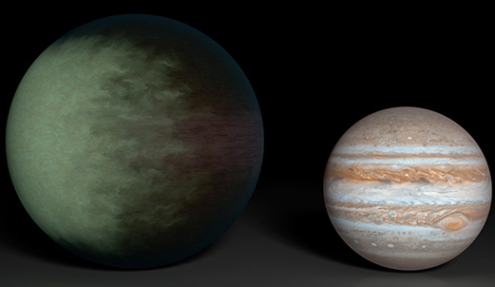
Kepler-7b (left), which is 1.5 times the radius of Jupiter (right), is the first exoplanet to have its clouds mapped. The cloud map was produced using data from NASA’s Kepler and Spitzer space telescopes. Image credit: NASA/JPL-Caltech/MIT
Things have been rather slow lately, but I saw this on NASA’s Jet Propulsion Laboratory’s website and found it rather interesting.
PASADENA, Calif. — Astronomers using data from NASA’s Kepler and Spitzer space telescopes have created the first cloud map of a planet beyond our solar system, a sizzling, Jupiter-like world known as Kepler-7b.
The planet is marked by high clouds in the west and clear skies in the east. Previous studies from Spitzer have resulted in temperature maps of planets orbiting other stars, but this is the first look at cloud structures on a distant world.
“By observing this planet with Spitzer and Kepler for more than three years, we were able to produce a very low-resolution ‘map’ of this giant, gaseous planet,” said Brice-Olivier Demory of Massachusetts Institute of Technology in Cambridge. Demory is lead author of a paper accepted for publication in the Astrophysical Journal Letters. “We wouldn’t expect to see oceans or continents on this type of world, but we detected a clear, reflective signature that we interpreted as clouds.”
Kepler has discovered more than 150 exoplanets, which are planets outside our solar system, and Kepler-7b was one of the first. The telescope’s problematic reaction wheels prevent it from hunting planets any more, but astronomers continue to pore over almost four years’ worth of collected data.
Read the whole press release here.
It looks like the ending credits from Star Trek: Into Darkness aren’t that far fetched after-all.
httpv://www.youtube.com/watch?v=_-W6XIWOiMA
